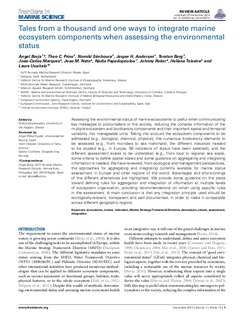| dc.contributor.author | Borja, Angel | |
| dc.contributor.author | Prins, Theo C. | |
| dc.contributor.author | Simboura, Nomiki | |
| dc.contributor.author | Andersen, Jesper Harbo | |
| dc.contributor.author | Berg, Torsten | |
| dc.contributor.author | Marques, Joao-Carlos | |
| dc.contributor.author | Neto, Joao M. | |
| dc.contributor.author | Papadopoulou, Nadia | |
| dc.contributor.author | Reker, Johnny | |
| dc.contributor.author | Teixeira, Heliana | |
| dc.contributor.author | Uusitalo, Laura | |
| dc.date.accessioned | 2018-08-02T13:23:02Z | |
| dc.date.available | 2018-08-02T13:23:02Z | |
| dc.date.created | 2015-01-26T13:09:11Z | |
| dc.date.issued | 2014 | |
| dc.identifier.citation | Frontiers in Marine Science. 2014, 1, 20: 72. | nb_NO |
| dc.identifier.issn | 2296-7745 | |
| dc.identifier.uri | http://hdl.handle.net/11250/2507323 | |
| dc.description.abstract | Assessing the environmental status of marine ecosystems is useful when communicating key messages to policy makers or the society, reducing the complex information of the multiple ecosystem and biodiversity components and their important spatial and temporal variability into manageable units. Taking into account the ecosystem components to be addressed(e.g., biological, chemical, physical), the numerous biodiversity elements to be assessed(e.g., from microbes to sea mammals), the different indicators needed to be studied(e.g., in Europe, 56 indicators of status have been selected), and the different assessment scales to be undertaken(e.g., from local to regional seascale), some criteria to define spatial scales and some guidance on aggregating and integrating information is needed. We have reviewed, from ecological and management perspectives, the approaches for aggregating and integrating currently available for marine status assessment in Europe and other regions of the world. Advantages and shortcomings of the different alternatives are highlighted. We provide some guidance on the steps toward defining rules for aggregation and integration of information at multiple levels of ecosystem organization, providing recommendations on when using specific rules in the assessment. A main conclusion is that any integration principle used should be ecologically-relevant, transparent and well documented, in order to make it comparable across different geographic regions. | nb_NO |
| dc.language.iso | eng | nb_NO |
| dc.publisher | Frontiers Media | nb_NO |
| dc.rights | Navngivelse 4.0 Internasjonal | * |
| dc.rights.uri | http://creativecommons.org/licenses/by/4.0/deed.no | * |
| dc.title | Tales from a thousand and one ways to integrate marine ecosystem components when assessing the environmental status | nb_NO |
| dc.type | Journal article | nb_NO |
| dc.type | Peer reviewed | nb_NO |
| dc.description.version | publishedVersion | nb_NO |
| dc.rights.holder | Copyright © 2014 Borja, Prins, Simboura, Andersen, Berg, Marques, Neto, Papadopoulou, Reker, Teixeira and Uusitalo. | nb_NO |
| dc.source.pagenumber | 20 | nb_NO |
| dc.source.volume | 1 | nb_NO |
| dc.source.journal | Frontiers in Marine Science | nb_NO |
| dc.identifier.doi | 10.3389/fmars.2014.00072 | |
| dc.identifier.cristin | 1207268 | |
| dc.relation.project | EC/FP7/308392 | nb_NO |
| dc.relation.project | EU/ENV.D2/FRA/2012/0019 | nb_NO |
| cristin.unitcode | 7464,60,0,0 | |
| cristin.unitname | NIVA Danmark | |
| cristin.ispublished | true | |
| cristin.fulltext | original | |
| cristin.qualitycode | 1 | |

